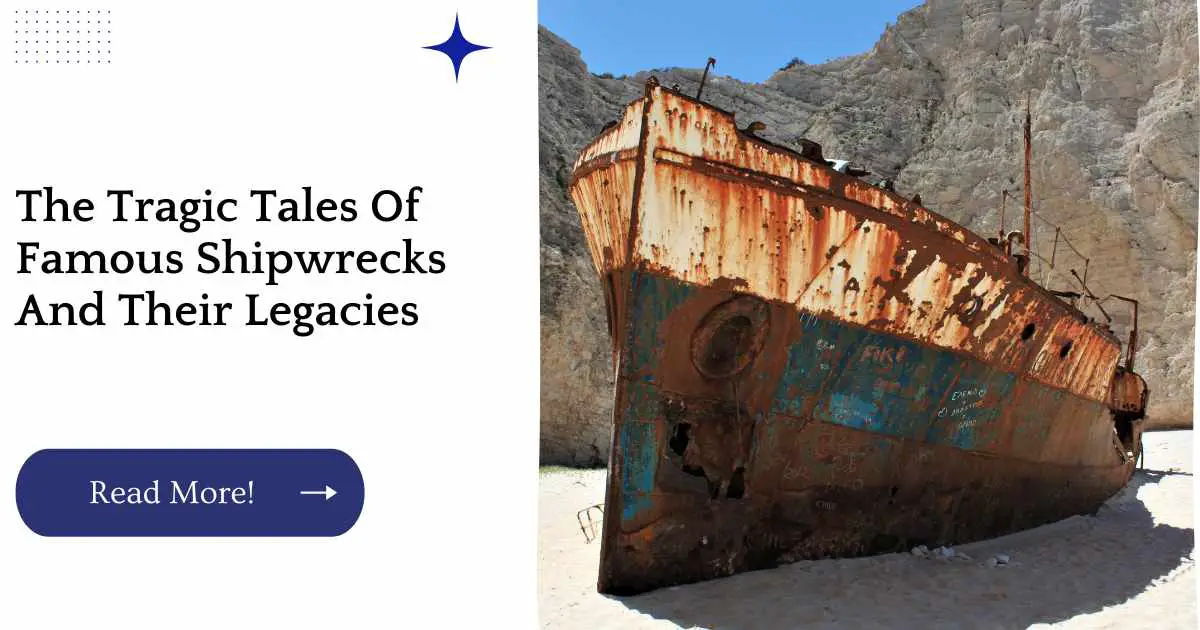The ocean is a beautiful, powerful place. It’s also a treacherous one. The sea can be cruel, and it has claimed countless lives throughout history.
But even more than that: It also fascinated us with its secrets and bizarre tales of tragedy especially when it comes to ships lost at sea.
| Takeaways |
|---|
| The tragic tales of famous shipwrecks and their legacies reveal fascinating stories about human history and exploration. |
| Salvaging shipwrecks can be a complex and challenging process, but with the right equipment and expertise, hidden treasures can be uncovered. |
| Shipwreck diving is a thrilling adventure that requires specialized training and equipment, but the discoveries made can provide valuable insights into history and the ocean’s ecology. |
| Underwater archaeologists play a crucial role in uncovering the secrets of shipwrecks and the stories they tell, using specialized tools and techniques to explore the ocean floor. |
| Further reading on shipwrecks, their history, and the techniques used in their exploration can provide a deeper understanding of these fascinating relics of the past. |
We’ve all heard of the Titanic, but there are so many other notable ships that met their fate under mysterious circumstances (and sometimes not-so-mysterious). Here are some of the most interesting stories behind these iconic maritime disasters:
R.M.S. Titanic
The story of the RMS Titanic, which sank on its maiden voyage, is perhaps one of the most famous shipwrecks in history. The Titanic was a British passenger liner that struck an iceberg on April 14, 1912 and sank in the North Atlantic Ocean with more than 1,500 passengers and crew aboard.
The sinking of the Titanic was one of history’s worst maritime disasters. It remains one of humanity’s most enduring mysteries: how could such an enormous ship be so vulnerable to something as small as an iceberg?
Why didn’t someone see it coming? And why couldn’t anyone escape? To answer these questions (and many others) we’ll explore what happened when this “unsinkable” luxury liner hit an iceberg and sunk into freezing waters off Newfoundland on April 14th 1912 – just hours from reaching New York City where it was due to dock after crossing from Southampton England.
“The process of salvaging shipwrecks can be a challenging and complex operation. However, with the right equipment and expertise, it’s possible to uncover hidden treasures beneath the waves. Learn more about the techniques used in shipwreck salvage operations and the incredible discoveries that have been made.”
S.S. Central America
The S.S. Central America was a sailing ship that sank in 1857 on its way home to New York from California.
She carried gold bars and nuggets, which were worth approximately $1 million at the time of her sinking a fortune by any account!
The Central America became the first US transatlantic steamship when she made it back from Liverpool, England, after being damaged by bad weather and losing many crew members to disease along the way.
The journey took about two months longer than expected because of these complications but nevertheless led to an increased interest in Atlantic trade routes among American merchants who wanted an alternative route for transporting goods between Europe and North America.
The loss of this ship is considered one of history’s greatest tragedies because it inspired Timothy Everest’s song “The Wreck Of The Edmund Fitzgerald” (1977) which tells the story from both sides: those aboard who lost their lives as well as those left behind waiting for news about what happened (the title comes from one surviving sailor).
Oceanos
The Oceanos was a cruise ship that sank in 1994. It was carrying 425 passengers and crew when it went down, and the cause of the sinking is unknown.
The ship still rests at the bottom of the Atlantic Ocean, but you can visit an exhibit featuring some of its artifacts at the Maritime Museum of Piraeus in Greece.
USS Arizona
The USS Arizona is a Pennsylvania-class battleship built for and by the United States Navy. It was laid down, launched and commissioned within a year, on October 17, 1915.
The ship was sunk in Pearl Harbor on December 7th 1941 as part of the Japanese surprise attack on Pearl Harbor known as Operation Z during World War II. It remains there today as a memorial to all those who died that day and was designated a National Historic Landmark in 1986.
“Exploring the deep sea and discovering shipwrecks is a thrilling adventure that requires specialized training and equipment. If you’re interested in the world of shipwreck diving, our guide to exploring the deep can help you get started and provide insights into the incredible discoveries that await.”
Franconia
The Franconia was a British ocean liner that was sunk by a German U-boat off the coast of Brazil in 1942. At the time, it was carrying 1,000 passengers and crew members on its way to New York City when it was attacked. The ship sank in just 20 minutes, killing 617 people.
While many people know about the tragedy that occurred aboard the Lusitania (see below), not many know about this ship’s story—which is why we’ve decided to dedicate our coverage of World War II shipwrecks to it this week!
Costa Concordia
The Costa Concordia was a cruise ship that sank off the coast of Italy in 2012. The ship was carrying over 4,000 passengers and crew, and when it ran aground just outside the Tuscan island of Giglio, 32 people lost their lives. The tragedy was made even more tragic by the fact that this was not the first time something like this had happened.
The Costa Concordia had been operated by Costa Cruises since 2005 (and before that it belonged to Carnival Corporation).
It’s one of two identical ships Costa Atlantica is its twin and both were built especially for the Mediterranean cruise market by Fincantieri Marine Group in Italy.
Once complete, each vessel cost about $1 billion to build ($1 billion being around $900 million), making them some of the most expensive ships ever constructed at the time they were built.
The cost came from extensive research into passenger comfort: everything from how quickly passengers could get on board to how quickly they could disembark; what kind of food they would like served at dinner; whether they wanted movies shown in their cabins or simply music played through speakers; whether all cabins should have private bathrooms or shared communal ones…the list goes on!
“Underwater archaeologists play a crucial role in uncovering the secrets of shipwrecks and the stories they tell. If you’re interested in the work of these professionals, check out our guide to underwater archaeology and learn about the tools and techniques used to explore the ocean floor.”
SS Edmund Fitzgerald
The Edmund Fitzgerald was a freighter built in 1958. It went down in 1975, after being struck by a storm while traveling through Lake Superior.
The ship’s sinking is remembered by Gordon Lightfoot’s song “The Wreck of the Edmund Fitzgerald,” which became an American folk standard and reached No. 1 on Billboard’s Hot 100 chart that same year—and it continues to be performed today as part of Lightfoot’s repertoire.
A memorial at Whitefish Point marks where the vessel sank; it features an anchor and plaque commemorating those who died during this tragic event.
The Mary Rose
You’ve probably heard of the Mary Rose, the Tudor warship that sank in 1545. You may not have known that its discovery and reconstruction were a long process.
After it was found in the Solent in 1971, it took 36 years to raise it from its resting place at a depth of 30 meters (100 feet), where it had been since 1545. It was finally raised on 11 October 1982 and transported by sea to Portsmouth Historic Dockyard where visitors can see it today.
In 2012, after much effort and expense, this famous ship re-opened to the public with its reconstructed decks opened up so visitors can walk around them as they did when they were sailing under King Henry’s command.
“The thrill of discovering lost treasures buried beneath the waves is hard to beat, and the history behind these shipwrecks is just as fascinating. Dive deeper into the exciting world of shipwreck exploration and learn more about the stories behind these relics with our guide to shipwreck exploration.”
The Vasa
The Vasa was a Swedish warship built in the 1620s. It sank on its maiden voyage in 1628, killing an estimated 50 people (including the king). The ship was raised from the bottom of Stockholm harbor in 1961 and is now on display at the Vasa Museum, where you can see it for yourself.
Conclusion
We hope you’ve enjoyed this look at some of the most famous shipwrecks in history. While these tragedies occurred hundreds of years ago, they continue to fascinate and inspire us today.
The stories behind each wreck are unique and fascinating, but they all share one thing: a legacy that lives on in our imaginations and our hearts.
“From ancient treasure to modern-day relics, shipwrecks have been a source of incredible discoveries throughout history. Our guide to fascinating shipwreck discoveries showcases some of the most impressive finds ever made, including precious artifacts and hidden treasures waiting to be uncovered.”
Further Reading
For more information on shipwrecks and their history, check out these additional resources:
18 Famous Shipwrecks in the World: This article provides a comprehensive list of some of the most famous shipwrecks throughout history and the stories behind them.
Five Books About Shipwrecks and Their Explorers: Dive deeper into the world of shipwreck exploration with these five books recommended by Scuba Diving magazine.
A Race Against Time: How Shipwrecks Hold Clues to Humanity’s Future: This article from The Guardian explores how shipwrecks can offer valuable insights into climate change and the future of humanity.
FAQs
What are some of the most famous shipwrecks in history?
Some of the most famous shipwrecks include the Titanic, the Lusitania, the Andrea Doria, and the Mary Rose, among others.
How do shipwrecks offer insights into the future of humanity?
Shipwrecks can reveal information about climate change and its effects on the ocean, as well as provide insights into historical patterns of human activity and resource use.
What are some popular books about shipwrecks and their explorers?
Some popular books about shipwrecks and their explorers include Shadow Divers by Robert Kurson, In the Heart of the Sea by Nathaniel Philbrick, and The Lost City of Z by David Grann.
What techniques are used in shipwreck exploration and salvage operations?
Techniques used in shipwreck exploration and salvage operations include sonar imaging, remotely operated vehicles (ROVs), and deep-sea diving.
What are some of the dangers associated with shipwreck exploration?
Dangers associated with shipwreck exploration include the risks of deep-sea diving, the potential for encountering hazardous materials or unexploded ordnance, and the risk of damage to the wreck itself.

Hi there! My name is Hellen James, and I’m here to talk to you about treasure hunting. I’ve been a fan of treasure hunting ever since I was a kid, and if you’re a fan of treasure hunting or just like the idea of finding a long-lost fortune, then this blog is for you.

